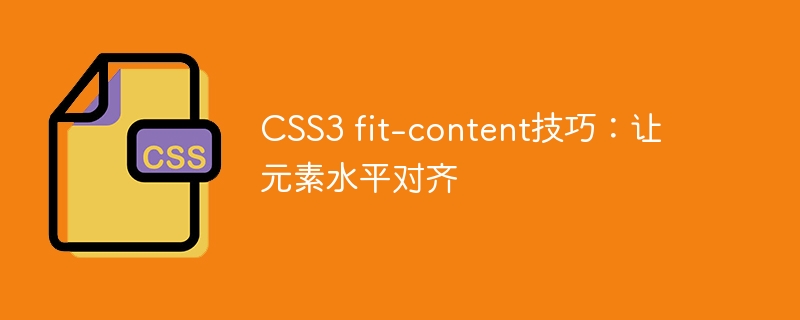Home >Web Front-end >CSS Tutorial >CSS3 fit-content trick: align elements horizontally
CSS3 fit-content trick: align elements horizontally
- WBOYWBOYWBOYWBOYWBOYWBOYWBOYWBOYWBOYWBOYWBOYWBOYWBOriginal
- 2023-09-09 11:39:211424browse

CSS3 fit-content technique: Align elements horizontally
In web development, we often encounter situations where multiple elements need to be aligned horizontally. Traditional solutions are usually implemented using flexbox or display: inline-block, but these methods may not necessarily meet all needs. Fortunately, CSS3 introduces the fit-content attribute, which can easily achieve horizontal alignment of elements. This article will introduce how to use the fit-content attribute and related code examples.
fit-content is a new attribute in CSS3, which is used to specify that the size of the element is adaptive according to the size of the content. When using the fit-content attribute, you can set a minimum and maximum value for the width or height of the element. The actual size of the element automatically adjusts between the minimum and maximum values to fit the size of the element's content. The fit-content attribute can be used with other box model attributes, such as width, height, flex, etc., to achieve different effects.
Let’s look at some specific code examples to demonstrate how to use the fit-content attribute.
Code example 1: Implement horizontal alignment of multiple block-level elements
<!DOCTYPE html>
<html>
<head>
<style>
.container {
width: fit-content;
margin: 0 auto;
border: 1px solid #000;
padding: 10px;
}
.box {
display: inline-block;
width: 200px;
height: 200px;
margin: 10px;
background-color: #f00;
}
</style>
</head>
<body>
<div class="container">
<div class="box"></div>
<div class="box"></div>
<div class="box"></div>
</div>
</body>
</html>In the above example, we use the fit-content attribute to set the width of the .container element to the actual size of the content. By setting the display attribute of the .container element to block and adding a centered margin value, the effect of horizontally centering alignment of multiple block-level elements is achieved.
Code Example 2: Achieve horizontal alignment of multiple inline elements
<!DOCTYPE html>
<html>
<head>
<style>
.container {
width: fit-content;
margin: 0 auto;
border: 1px solid #000;
padding: 10px;
}
.box {
display: inline;
width: 200px;
height: 200px;
margin: 10px;
background-color: #f00;
}
</style>
</head>
<body>
<div class="container">
<div class="box"></div>
<div class="box"></div>
<div class="box"></div>
</div>
</body>
</html>In the above example, we use the fit-content attribute to also set the width of the .container element to the actual size of the content. By setting the display attribute of the .box element to inline, multiple inline elements can be displayed on one line and aligned horizontally.
By using the fit-content attribute, we can easily achieve the horizontal alignment effect of elements. Whether it is a block-level element or an inline element, you can flexibly apply this attribute for layout. However, it should be noted that the fit-content attribute has limited compatibility and may not work properly in some older versions of browsers. Therefore, when using the fit-content attribute, it is recommended to use other layout solutions for compatibility processing.
To summarize, the CSS3 fit-content technique can help us achieve horizontal alignment of elements. By setting the width or height of an element to fit-content, the element can be automatically resized according to the actual size of the content. Whether it is a block-level element or an inline element, we can use the fit-content attribute to achieve different horizontal alignment effects in different situations. I hope this article can help everyone better understand and apply the fit-content attribute.
The above is the detailed content of CSS3 fit-content trick: align elements horizontally. For more information, please follow other related articles on the PHP Chinese website!

